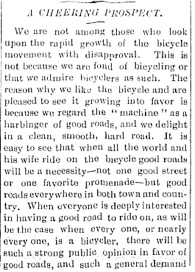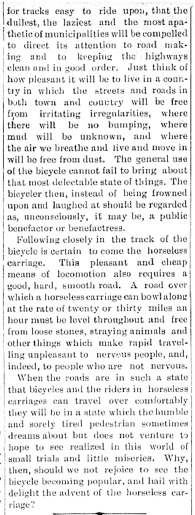Cycle Babble: Places



The impact of cycling on city spaces was not uncontested. Frequent outbursts of anger from pedestrians appear in the Colonist, such as the letter writer who asked, "Is there a law to prevent cyclists from riding on the sidewalk, and, if they persist in doing so, is there a law to prevent one from upsetting them?"(16) This shows that, as with other new technologies, the bike met with resistance from some people. As Norcliffe says, "shopkeepers and pedestrians loudly protested the use by cyclists of the smoothest place to ride — the sidewalks."(17)
Roads
"Innovations make demands on infrastructure," writes Norcliffe, pointing to trains, shipping, electric lighting and computers as innovations that required infrastructure investment. He then connects this to cycling: "the interest of Victorian bicyclists in improving and modernizing the infrastructure they used forms part of a larger pattern."(1) He claims that cyclists were part of a broader movement that demanded better road conditions, but that they often came into conflict with other road users. In Victoria, there was a generally supportive city council that provided good road conditions for cyclists, which meant that cyclists in Victoria did not join the wider North American push for good roads in as significant a manner as they did elsewhere, although there was conflict with other road users.
Norcliffe reports that Colonel Albert Pope, the famous American cycle manufacturer and advocate, was impressed with Victoria's roads when he visited in 1892. Norcliffe quotes an article Pope wrote for Forum magazine:
"'Those who have visited the island of Vancouver and especially the neighbourhood of Victoria, will have appreciated the fact that the high roads there are immensely superior to most of our own country. Their excellent condition is due mainly to the centralization of provincial government in British Columbia, and to the energy and talent of the late Governor Douglas, who personally directed all public improvements.'"(2)
Governor Douglas may have laid out a good road network in and around Victoria, but it is not clear from the available evidence whether he was responsible for the good condition of the roads within the city fifteen years after his death in 1877 and thirty years after Victoria had been incorporated as a city in 1862. Evidence from the City's Annual Reports indicates that the city spent a lot of money grading, graveling, macadamizing, repairing and paving roads during the 1890s. Summertime sprinkling to avoid dust was also an important part of the city's involvement in maintaining "superior" infrastructure used by cyclists. Municipal officials did, indeed, seem to be concerned with creating good roads for all users and should be granted credit for funding and directing much of the improvements that benefited these users.
Macdamizing was one of the best road surfaces for cyclists in the 1890s, since it provided a relatively smooth ride.(3) Every year during the 1890s, the city spent a large portion of its road budget macadamizing many streets. For instance, the City's annual report for 1890 lists thirty streets that were partially macadamized (4). The annual reports also state that expenditures during the 1890s ranged from a few thousand to many thousands of dollars. Wood block paving is first mentioned in the Annual Report for 1900, with the street superintendent noting that it "gives the central part of the city a greatly improved appearance.(5) Of course, macadamizing and other paving benefited all road users, not just cyclists. However, Victoria's expenditures on streets did make it a good place to ride.
Also of importance to early cyclists in Victoria was the amount of dust that collected on roads during the summer months. With much of the city's roads still consisting of gravel and dirt during the 1890s, dust was a problem recognized by the city. The only explicit mention of bicycles in the city's annual streets reports during the 1890s is about sprinkling roads during the hot summer months, when most riding would have taken place. "In regard to street sprinkling and bicycles, in my opinion the practice of Eastern cities could be followed out to advantage in Victoria," writes C. H. Topp, the City Engineer, in the 1899 Annual Report.(6) He then goes on to suggest a two-and-three-quarter cent "per foot frontage" tax on properties to help pay for more carts to haul sprinklers through the streets. He also suggests "a nominal tax" on bicycles to fund the creation of bicycle paths in the city, saying that if these two suggestions were acted upon, "the bicylce would be in use practically throughout the year."(7) However, no more is said about either of these proposals in the following annual report and it is not clear whether the dusty roads of summer would turn into muddy roads that were impassible to cyclists during the winter. However there is a recognition in this report that cycling is potentially a year round activity in Victoria, as opposed to elsewhere in the country that Norcliffe describes. For instance, he says that part of the reason bikes did not catch as commuting machines on in Canada is "owing partly to the Canadian climate."(8) It is still much the same in Canada, where Victoria's climate allows year round cycling while in other parts of Canada the climate makes it difficult.
There is some evidence that cyclists were interested in pushing for better roads and accommodation of their needs in the middle of the 1890s, but little seems to have been done until 1900. A short notice in the British Colonist on August 6, 1895 said that there was a meeting of the Victoria Wheelman's Club, "in connection with the formation of a good roads association."(9) There was no follow up to this notice in the paper during the following days, although a petition was released by the Wheelmen calling for roads to be improved by the city on August 22.(10) The B.C. Good Roads Association was not formed until September 1900.(11) A Victoria branch was not formed until December of that year.(12) This was part of a larger movement in North America, led by national Good Roads Associations in each country. Norcliffe notes that cyclists were only a small part of the Association in both countries, but played a smaller role in Canada than in America.(13) The fact that the Farmers' Institute and the B.C. Good Roads Association met simultaneously in November 1900 (14) indicates that business and rural concerns were more important to the new association than cycling and urban concerns. However, there was still widespread public support for cycling as a "harbinger of good roads," as the Colonist put it on April 17, 1896.(15) The paper even explicitly connects good roads demanded by cyclists with another modernist invention, writing that good roads would make horseless carriages more usable on city streets. Even though they did not have their own organization to push for better roads, cyclists were therefore still recognized as politically and socially important in creating new kinds of modern spaces.
Copyright 2009. Vincent Gornall
“A Cheering Prospect,” The Daily Colonist, April 17, 1896, page 4, <http://www.britishcolonist.ca/display.php?issue=18960417>. (Parts 1 & 2).







